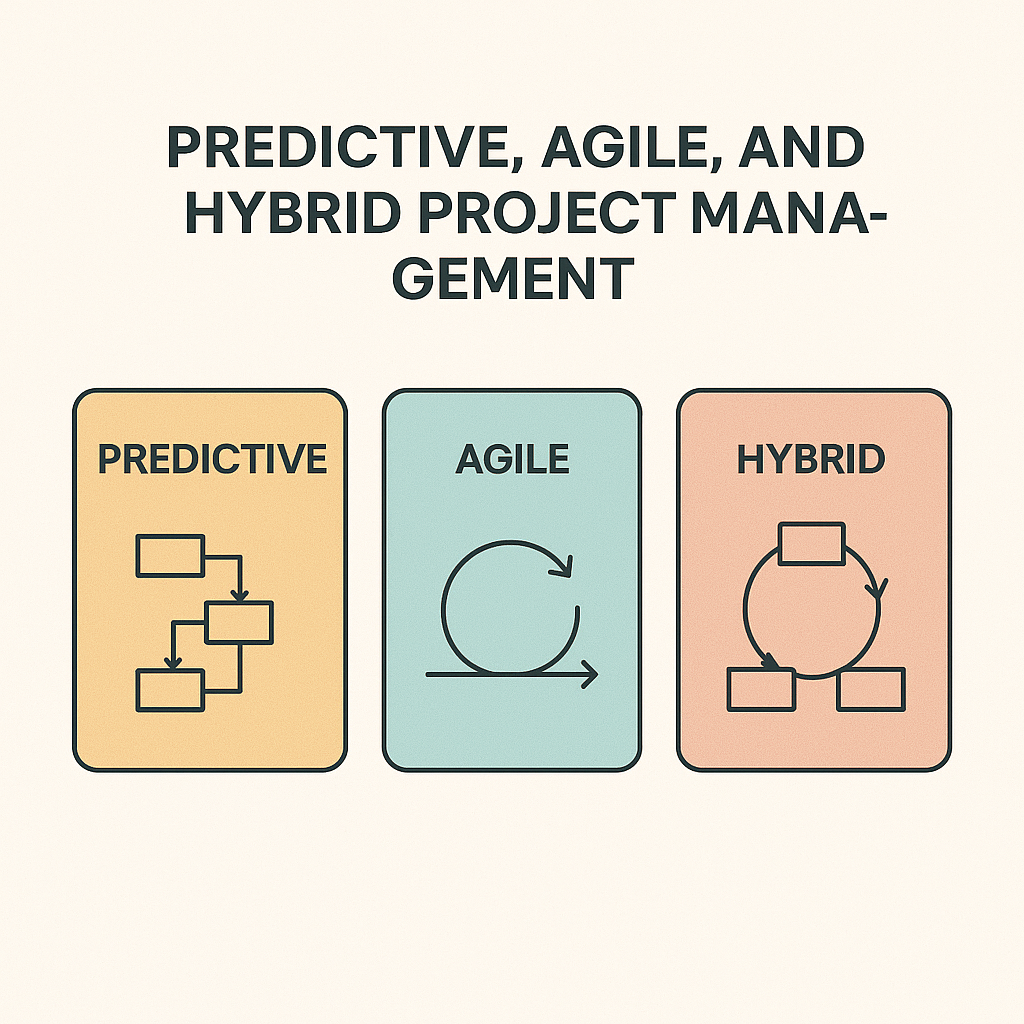
The three main types of project management are Predictive, Agile & Hybrid. Predictive project management is also known as traditional or waterfall. Agile is also known as Adaptive. Agile comprises of a family of frameworks like Scrum, XP, TDD, FDD, SaFe etc. Of these Scrum is the most popular one as it is not software specific. All agile methods are iterative and incremental in nature. Hybrid project management combines both Predictive & Agile.
The three models in detail;
- Predictive (Traditional) / Waterfall Project Management:
- Overview: Also known as traditional or waterfall project management, the predictive approach follows a linear, sequential process where the project progresses through predefined stages in a fixed sequence.
- Key Characteristics:
- Detailed planning is done upfront, and the entire scope of work is defined at the beginning of the project.
- Emphasis is placed on creating a comprehensive project plan, including scope, schedule, and budget, which serves as a baseline throughout the project lifecycle.
- Work is divided into distinct phases (e.g., initiation, planning, execution, monitoring/control, closure), and each phase must be completed before moving to the next.
- Changes to project scope, requirements, or deliverables are generally discouraged or managed through formal change control processes.
- Benefits:
- Clear project structure and defined processes facilitate planning and execution.
- Predictability and stability in project scope, schedule, and budget.
- Suitable for projects with well-understood requirements and stable environments.
- Agile Project Management:
- Overview: Agile is an iterative and incremental approach to project management, emphasizing flexibility, collaboration, and responsiveness to change. It evolved as a response to the limitations of traditional predictive approaches, especially in dynamic and uncertain environments.
- Key Characteristics:
- Iterative development cycles (sprints) allow for frequent inspection and adaptation of project deliverables based on stakeholder feedback.
- Cross-functional teams work collaboratively in short iterations to deliver incremental value, with a focus on delivering the highest priority features first.
- Requirements are captured and prioritized in a backlog, and the scope is continuously refined and adjusted based on customer feedback and changing priorities.
- Emphasis is placed on customer collaboration, adaptability, and responding to change over following a rigid plan.
- Benefits:
- Flexibility to adapt to changing requirements and priorities.
- Continuous delivery of value and early stakeholder feedback.
- Encourages collaboration, self-organization, and empowerment within the project team.
- Common Agile Frameworks: Scrum, Kanban, Extreme Programming (XP).
- Hybrid Project Management:
- Overview: Hybrid project management combines elements of both predictive and Agile approaches to leverage the strengths of each methodology and tailor the approach to the specific needs of the project.
- Key Characteristics:
- Hybrid projects may adopt a predictive approach for certain aspects of the project (e.g., planning, budgeting) while incorporating Agile principles for other aspects (e.g., development, testing).
- Project managers have the flexibility to adapt the project management approach based on project complexity, stakeholder preferences, and environmental factors.
- Hybrid approaches allow for a balance between predictability and adaptability, offering the best of both worlds.
- Benefits:
- Flexibility to tailor the project management approach to suit project requirements and constraints.
- Ability to leverage Agile principles for iterative development and responsiveness to change while maintaining control and predictability in project planning and execution.
- Suitable for projects with a mix of well-defined and evolving requirements, or projects operating in uncertain or dynamic environments.
In summary, while predictive, Agile, and hybrid project management approaches differ in their methodologies and philosophies, each approach offers unique benefits and is suitable for different project contexts. The choice of approach depends on factors such as project objectives, scope, complexity, stakeholder preferences, and organizational culture. Organizations may choose to adopt one approach exclusively or combine elements from multiple approaches to create a tailored project management framework that best suits their needs.

